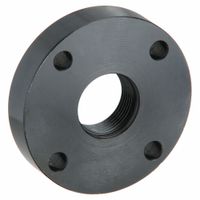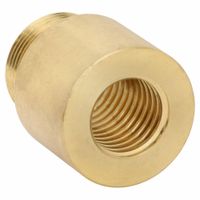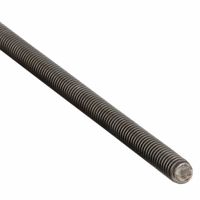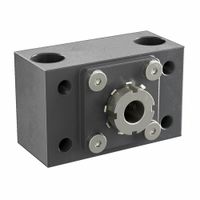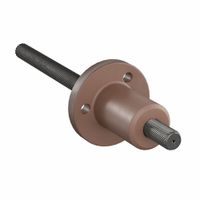Call +(254) 703 030 000 / 751 483 999 / 721 704 777
- Home
- Power Transmission
- Linear Motion
- Ball Screws Lead Screws
.....Read More
Frequently Asked Questions
What are the main differences between ball screws and acme lead screws?
Ball screws and acme lead screws are both used to convert rotational motion into linear motion, but they have distinct differences:
1. **Design and Components**:
- **Ball Screws**: Consist of a threaded shaft and a nut with recirculating ball bearings. The balls reduce friction and wear, allowing for smooth motion.
- **Acme Lead Screws**: Feature a trapezoidal thread profile and a nut that directly contacts the screw, leading to higher friction.
2. **Efficiency**:
- **Ball Screws**: High efficiency (over 90%) due to rolling motion of the balls, resulting in less energy loss.
- **Acme Lead Screws**: Lower efficiency (typically 20-40%) due to sliding friction between the nut and screw.
3. **Load Capacity**:
- **Ball Screws**: Can handle higher loads and are suitable for high-speed applications.
- **Acme Lead Screws**: Better suited for moderate loads and lower speeds.
4. **Backlash and Precision**:
- **Ball Screws**: Minimal backlash due to preloaded ball bearings, offering high precision and repeatability.
- **Acme Lead Screws**: More prone to backlash, though anti-backlash nuts can be used to improve precision.
5. **Self-Locking**:
- **Ball Screws**: Not self-locking, requiring a brake or motor to hold position.
- **Acme Lead Screws**: Often self-locking, preventing back-driving under load.
6. **Cost and Maintenance**:
- **Ball Screws**: More expensive and require regular maintenance to ensure longevity.
- **Acme Lead Screws**: Generally cheaper and require less maintenance.
7. **Applications**:
- **Ball Screws**: Used in CNC machines, robotics, and applications requiring high precision.
- **Acme Lead Screws**: Common in applications where cost is a concern and precision is less critical, like clamps and vises.
How do I choose between a ball screw and an acme lead screw for my application?
To choose between a ball screw and an acme lead screw, consider the following factors:
1. **Efficiency**: Ball screws are more efficient (90%+) than acme screws (20-40%) due to reduced friction, making them suitable for high-speed applications.
2. **Load Capacity**: Ball screws handle higher loads and are ideal for applications requiring high precision and heavy-duty performance. Acme screws are better for moderate loads.
3. **Precision and Accuracy**: Ball screws offer higher precision and repeatability, suitable for CNC machines and robotics. Acme screws are less precise but sufficient for applications where high accuracy is not critical.
4. **Backlash**: Ball screws have minimal backlash, enhancing accuracy. Acme screws may have more backlash, which can be reduced with anti-backlash nuts.
5. **Cost**: Ball screws are generally more expensive due to their complex design and higher performance. Acme screws are cost-effective for simpler applications.
6. **Maintenance**: Ball screws require regular lubrication and maintenance to prevent wear. Acme screws are more robust and require less maintenance.
7. **Environment**: Ball screws are sensitive to contamination and require clean environments. Acme screws are more tolerant of dirt and debris.
8. **Speed**: Ball screws support higher speeds due to their efficiency. Acme screws are better for low-speed applications.
9. **Noise**: Ball screws operate more quietly compared to acme screws, which can be noisy due to friction.
10. **Self-locking**: Acme screws can be self-locking, preventing back-driving without additional brakes, unlike ball screws.
Evaluate these factors based on your application's specific requirements to make an informed decision.
What are the advantages of using ball screws over acme lead screws?
Ball screws offer several advantages over acme lead screws:
1. **Efficiency**: Ball screws have rolling contact between the screw and the nut, which significantly reduces friction compared to the sliding contact in acme screws. This results in higher mechanical efficiency, often exceeding 90%, compared to 20-40% for acme screws.
2. **Precision and Accuracy**: Ball screws provide higher precision and repeatability due to their reduced friction and backlash. This makes them ideal for applications requiring high accuracy, such as CNC machinery and robotics.
3. **Load Capacity**: Ball screws can handle higher loads due to the distribution of forces over multiple ball bearings, which reduces wear and extends the lifespan of the screw.
4. **Speed**: The reduced friction in ball screws allows for higher operational speeds, making them suitable for applications that require rapid movement.
5. **Durability and Longevity**: The rolling action in ball screws minimizes wear, leading to a longer service life compared to acme screws, which experience more wear due to sliding friction.
6. **Reduced Heat Generation**: Lower friction in ball screws results in less heat generation, which can be beneficial in maintaining the stability and accuracy of the system.
7. **Lower Torque Requirements**: Due to their high efficiency, ball screws require less torque to achieve the same linear motion, which can lead to energy savings and the use of smaller motors.
8. **Minimal Backlash**: Ball screws can be preloaded to eliminate backlash, enhancing the precision of the system.
These advantages make ball screws a preferred choice in applications where precision, efficiency, and durability are critical.
How do I maintain and lubricate ball screws and acme lead screws?
To maintain and lubricate ball screws and acme lead screws, follow these steps:
1. **Regular Inspection**: Frequently inspect the screws for signs of wear, contamination, or damage. Look for unusual noise, vibration, or backlash during operation.
2. **Cleaning**: Clean the screws regularly to remove dust, dirt, and debris. Use a lint-free cloth and a suitable solvent to wipe down the screws. Avoid using high-pressure air as it can force contaminants into the screw assembly.
3. **Lubrication**:
- **Ball Screws**: Use a high-quality grease or oil specifically designed for ball screws. Apply the lubricant evenly along the length of the screw. Ensure the lubricant is compatible with the screw material and operating environment. Re-lubricate based on the manufacturer's recommendations or operational conditions.
- **Acme Lead Screws**: Use a heavier lubricant, such as a thick grease, to reduce friction and wear. Apply the grease along the threads and ensure it penetrates the nut. Reapply as needed, especially in high-load or high-speed applications.
4. **Environmental Protection**: Protect screws from harsh environments by using bellows or covers. This prevents contamination from dust, moisture, and chemicals.
5. **Alignment and Tension**: Ensure proper alignment and tension of the screws to prevent uneven wear and binding. Misalignment can lead to increased friction and premature failure.
6. **Temperature Monitoring**: Monitor the operating temperature of the screws. Excessive heat can degrade lubricants and cause thermal expansion, affecting performance.
7. **Documentation**: Keep a maintenance log detailing inspection dates, lubrication schedules, and any issues encountered. This helps in tracking performance and planning future maintenance.
By following these steps, you can extend the life and efficiency of ball screws and acme lead screws, ensuring optimal performance in your machinery.
What are the typical applications for ball screws and acme lead screws?
Ball screws and acme lead screws are both used to convert rotational motion into linear motion, but they have distinct applications due to their different characteristics.
**Ball Screws:**
1. **High Precision Machinery:** Ball screws are commonly used in CNC machines, 3D printers, and other precision machinery due to their high efficiency and accuracy. They provide smooth motion and can handle high loads with minimal friction.
2. **Robotics:** In robotics, ball screws are used for precise positioning and movement control, essential for tasks requiring high accuracy and repeatability.
3. **Aerospace:** Ball screws are employed in aircraft control surfaces and landing gear systems where reliability and precision are critical.
4. **Automotive:** They are used in power steering systems and electric vehicle actuators, where efficient and precise motion control is necessary.
5. **Medical Equipment:** Ball screws are found in medical devices like MRI machines and surgical robots, where precision and smooth operation are vital.
**Acme Lead Screws:**
1. **Industrial Machinery:** Acme lead screws are used in applications where high load capacity and durability are more important than precision, such as in heavy-duty industrial machinery and presses.
2. **Lifting Equipment:** They are often used in jacks, lifts, and other equipment where self-locking capability is beneficial to prevent back-driving under load.
3. **Manual Adjustment Devices:** Acme screws are suitable for applications requiring manual adjustments, such as in clamps, vises, and hand-operated machinery.
4. **Construction Equipment:** They are used in construction machinery for tasks that require robust and reliable linear motion under heavy loads.
5. **Agricultural Machinery:** Acme screws are found in equipment like seeders and plows, where ruggedness and the ability to handle dirt and debris are important.
Each type of screw is chosen based on the specific requirements of the application, such as load capacity, precision, efficiency, and environmental conditions.
How do I calculate the load capacity for ball screws and acme lead screws?
To calculate the load capacity for ball screws and acme lead screws, follow these steps:
1. **Determine the Screw Type and Specifications**: Identify whether you are using a ball screw or an acme lead screw. Gather specifications such as screw diameter, lead, and material properties.
2. **Calculate Critical Speed**: Use the formula:
\[
N_c = \frac{F_s \times 4.76 \times 10^6}{L^2}
\]
where \(N_c\) is the critical speed in RPM, \(F_s\) is the safety factor, and \(L\) is the unsupported length in mm.
3. **Calculate Column Load (Buckling Load)**: Use Euler's formula for long columns:
\[
P_{cr} = \frac{\pi^2 \times E \times I}{(K \times L)^2}
\]
where \(P_{cr}\) is the critical load, \(E\) is the modulus of elasticity, \(I\) is the moment of inertia, \(K\) is the column effective length factor, and \(L\) is the length.
4. **Determine Dynamic Load Capacity (for Ball Screws)**: Use the manufacturer's dynamic load rating \(C\) and apply:
\[
L_{10} = \left(\frac{C}{F_m}\right)^3
\]
where \(L_{10}\) is the life in revolutions, \(C\) is the dynamic load rating, and \(F_m\) is the mean load.
5. **Calculate Static Load Capacity**: For both screw types, use:
\[
F_s = \frac{A \times \sigma_y}{F_s}
\]
where \(F_s\) is the static load capacity, \(A\) is the cross-sectional area, \(\sigma_y\) is the yield strength, and \(F_s\) is the safety factor.
6. **Consider Safety Factors**: Apply appropriate safety factors based on application conditions, such as shock loads or continuous operation.
7. **Consult Manufacturer Data**: Always refer to manufacturer specifications for precise load ratings and factors specific to the screw model and application.
What are the common causes of failure in ball screws and acme lead screws?
Common causes of failure in ball screws and acme lead screws include:
1. **Wear and Tear**: Continuous operation leads to material degradation. In ball screws, this manifests as wear on the ball bearings and raceways. In acme screws, the threads wear down, reducing efficiency and accuracy.
2. **Contamination**: Dirt, dust, and other particulates can infiltrate the screw mechanism, causing abrasion and accelerated wear. Ball screws are particularly susceptible due to their precision components.
3. **Improper Lubrication**: Insufficient or inappropriate lubrication increases friction and wear. Ball screws require specific lubricants to maintain smooth operation, while acme screws need regular lubrication to prevent thread wear.
4. **Overloading**: Exceeding the load capacity can cause deformation or breakage. Ball screws may experience brinelling or indentation of the raceways, while acme screws can suffer from thread stripping or bending.
5. **Misalignment**: Incorrect alignment during installation or operation leads to uneven load distribution, causing premature wear or failure. This is critical for ball screws, which require precise alignment for optimal performance.
6. **Corrosion**: Exposure to corrosive environments can degrade materials, leading to pitting and weakening of the screw components. Stainless steel or coated screws are often used to mitigate this risk.
7. **Fatigue**: Repeated stress cycles can cause fatigue failure. Ball screws are prone to fatigue in the balls and raceways, while acme screws may experience fatigue in the threads.
8. **Thermal Expansion**: Temperature fluctuations can cause expansion or contraction, leading to misalignment or increased stress on the components.
9. **Improper Installation**: Incorrect installation techniques can lead to misalignment, inadequate preload, or improper tensioning, all of which contribute to premature failure.
10. **Vibration and Shock Loads**: Excessive vibration or sudden shock loads can cause mechanical damage or misalignment, particularly in high-speed applications.
